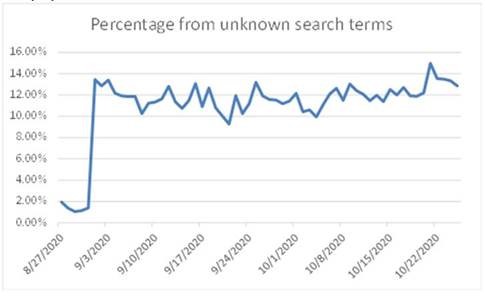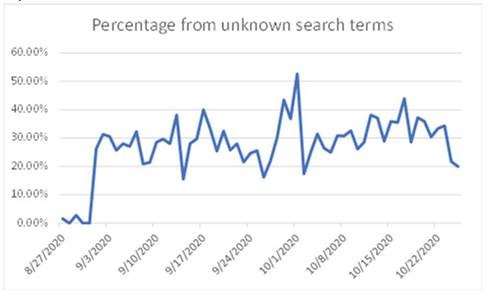Google Ads Search Terms Report Update
[vc_row][vc_column][vc_column_text el_id=”update”]
UPDATE: Google Ads Removes Search Terms For Up To 55% of Paid Search Budgets
Transparency in digital ad spend is important to us at Location3. We even built out an entire digital marketing platform with the goal of increasing transparency by giving our franchise partners unfettered access to their campaign performance data, 24/7. Our publisher partners, likewise, value transparency by giving us valuable data to use for optimizations to ensure that we’re maximizing ROI. Unfortunately, due to a recent decision by Google to remove access to some of this data, we now have less visibility into what our clients’ target audience is searching for. And now, we must adapt.
Following up on a previous Location3 blog post published in the days immediately after Google’s announcement that they were going to begin limiting search terms report data to only show searches from a “significant” number of users, we now have data showing the actual impact of this decision on our active paid search campaigns at Location3.
Thanks to the work of Fred Vallaeys (@siliconvallaeys) and our friends at Optmyzr, we can now run a quick script in Google Ads to see exactly how much data has been lost since the change took effect on September 2, 2020. It doesn’t take a data scientist to see that Google is now showing us significantly less of the valuable data that account managers use to improve the quality and profitability of traffic driven to our partners’ websites via paid search ads.
The findings are consistent across campaigns. Data loss clearly begins on September 2 with a loss range of 15% to upwards of 55%. Search terms data loss is more pronounced for non-brand keywords (targeting searches that do not include the advertiser’s brand name) than brand keywords (targeting searches that include the brand name). And according to a recent report released by Tinuiti, there has been a significant drop in data across ad formats and device types. Here’s just a quick snapshot of what we’ve seen across some of our campaigns:

Brand keyword data loss on a Location3 B2C campaign.

Non-brand keyword data loss on a Location3 B2C campaign.
How We Adapt
With the understanding that we live in a Google-centric world, how do we adapt to this change? Luckily, the tools and tactics already exist – we just need to leverage them more heavily moving forward. Here are a few tools we’re using at Location3 to combat search terms data loss:
Negative Keyword Research
This change combined with the expansion of close variants means that negative keyword research is just as important as positive keyword research. We use existing tools, such as Google Ads Keyword Planner, Answer The Public, and Microsoft Advertising Search Terms Reports, to ensure that we’re maximizing traffic quality from day one of our campaigns.
Audience & Demographic Targeting
We layer audience and demographic targeting on top of existing keyword targeting to ensure that even with our most broad keywords we’re reaching the right searcher. This of course includes site remarketing, in-market audiences, and my personal favorite, Customer Match, which allows us to leverage first-party data to target past customers and searchers who share the same attributes as past customers.
Geo-Targeting Exclusions
Just as negative keywords have increased in importance, so to has geo-targeting exclusions. Google takes quite a bit of liberty in deciding where to show your ads. We take some of that control back by implementing geo-targeting exclusions for those far-flung areas containing a small percentage of our partners’ potential customer base. With this tactic we have the ability to exclude targeting people located in specific countries, states, cities, and zip codes.
While this change coming from Google decreases transparency into exactly how paid search budgets are being used, we still have a plethora of tools and tactics in our toolbelts to use to ensure that we are good stewards of our clients’ budgets. Usage of these tools and tactics is no longer optional; it is now mandatory.
[/vc_column_text][vc_separator][vc_column_text el_id=”ogPost”]

Photo by Mitchell Luo on Unsplash
Originally Posted September 9, 2020 | By Genevieve DePriest
Last week, Google alerted advertisers that the search terms report is being updated to include only the terms that were searched by a significant number of users. In other words, the report will stop showing queries that prompted ads when there is minimal data, or not enough to meet the as-yet undefined measure of ‘significant.’
In a statement to Search Engine Land, a Google spokesperson said that this change is about maintaining privacy standards and protecting user data. The implications for search engine marketing are too large, however, for advertisers to be placated by Google’s somewhat obtuse communication thus far.
Frustrations in the advertising world are centered on:
A) the lack of budgetary transparency – advertisers will potentially pay for irrelevant search terms but will lose the reporting piece that helps them trim the fat. According to some, advertisers could lose visibility into what amounts to a quarter or more of their ad spend.
B) the impact on negative keyword management – advertisers had been using low-volume keyword data to compile negative keyword lists to optimize campaigns.
C) Google hasn’t yet defined ‘significant’ – we don’t yet know the threshold for inclusion in the search terms report. The impact to ad campaigns and budgets will largely be determined by this measure.
Some advertisers are already seeing significant impacts. From one day of data collection from their clients, digital agency Seer Interactive found that Google Ads now “hides search terms for ~28% of Paid Search budgets and removes search term visibility of 20.4% of PPC clicks.”
Justin Salazar, Paid Search Strategist for Location3, writes,
It’s a story as old as the digital marketing world itself: Google giveth, and Google taketh away. At Location3 we regularly use search terms data to gain insight into searcher intent and optimize to improve campaign efficiency by ensuring that we’re showing the searcher an ad that is relevant, timely, and helpful. With the removal of a large chunk of this data, Google is potentially limiting our ability to dig into the data at the local level for valuable, market-specific insights that drive our campaigns and benefit both our clients and searchers on Google. Given that we live in a Google-centric world, we as search marketers must adapt to this new environment, and that might mean that we have to trade in our optimization scalpel for a battle axe.
We are looking to Google for further clarification and in the meantime, Location3 will continue to adapt our methodology and strategy to optimize campaigns for the greatest returns for our clients. Transparency for digital ad spend is important to us. [/vc_column_text][/vc_column][/vc_row]
Stay In Touch.
Subscribe to our monthly email newsletter.
